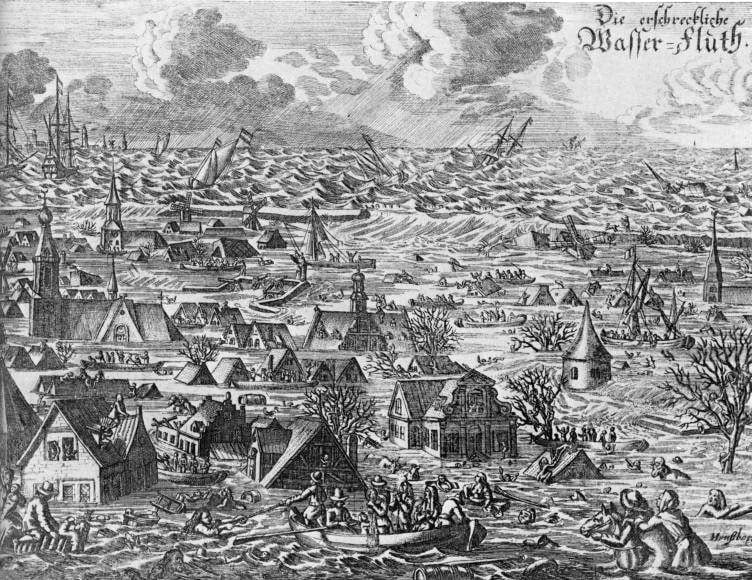*Image Credit: Wikimedia Commons The waters of the North Sea can be vicious, particularly as Arctic winds sweep down with increasing frequency in fall and winter months. On October 11, 1634, a wicked storm moved in from the southwest, boosting waves over the dike system in North Frisia and Dithmarschen. Weakened over the course of several years, the levees soon ruptured, flooding areas well into mainland Germany, destroying dozens of miles of coastline and drowning 15,000 people. All along the northern edge of Germany and eastern coast of Denmark, life had been incredibly difficult for decades. Since the beginning of the 17th century, the region had been hard hit by natural and manmade disasters. After suffering through a bout with the plague in 1603, locals attempted to defend themselves in the Thirty Years’ War against the attacks of Frederick III by working with the Danish navy. Ultimately unsuccessful, their military efforts distracted them from basic tasks like maintaining the dike system built to ward off the thrashing waves of the North Sea. October 11, 1634 had been a calm day, just like every day for months before it. However, as the evening progressed, strong winds from the northwest beat against the coastline. The North Sea, churning under the gale, hammered the dikes as the skies opened up with a heavy rain, lightning and hail. At 10pm, the first of several hundred breakthroughs occurred at Stintebull. Those residents who could rushed to high ground, hoping to avoid the wall of water crashing through town. Before long, villages throughout the area were submerged. At 2am, the waters reached their peak height — 13 feet above high tide, according to reports from the time. Flooding was so severe, dikes 40 miles away in the city of Hamburg gave way. Mother Nature’s fury had leveled much of Strand Island and killed 6,000 people and some 50,000 livestock. On the mainland, a further 2,000 of each were confirmed dead, while dozens of houses floated off their foundations and were dragged away. Historians suspect another 7,000 undocumented workers — those not registered with the local churches as frequent attendees — likely fell victim to the high waters. In the wake of the disaster, those who survived were left with a nightmarish scene. Once-beautiful beaches were littered with decaying corpses of man and beast, shattered remnants of homes and crops uprooted by the flow of water and carried away. It would take decades for the area to recover, absent the Old Nordstrand dialect of Frisian language — it had been wiped out when Strand Island’s population was killed. Even today, centuries later, farmland on the island is only a third the size of what it was before the storm hit. Also On This Day: 1138 – An earthquake in Aleppo, Syria kills an estimated 230,000 1852 – The University of Sydney holds its first classes 1884 – Birth of Eleanor Roosevelt, First Lady of the United States and humanitarian 1975 – Comedy show Saturday Night Live debuts 1986 – Humanitarian Mother Teresa walks away from a plane crash in Tanzania that kills six
October 11 1634 CE – The Burchardi Flood Kills 15,000 in Northern Germany
*Image Credit: Wikimedia Commons The waters of the North Sea can be vicious, particularly as Arctic winds sweep down with increasing frequency in fall and winter months. On October 11,…
874
